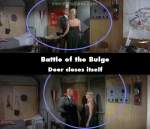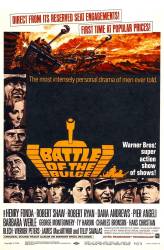
Continuity mistake: In the scene where Col. Hessler is visited by a courtesan, he refuses her "services", opens the door and hands her her fur coat. In the next shot, the door is closed again and the colonel still has the courtesan's fur coat. (00:42:50)
Factual error: None of the German tanks are accurate representations of German WWII types. They are all post war US variants. ie. M47 Patton Tanks. [Still a mistake, but an elaboration: This is a common problem in depicting German tanks: few, if any, survived the war. The few museum examples wouldn't be released for movie work, and certainly WHERE, some 20 years after the war, would one find a brigade's worth of running Tiger II tanks? Never mind that Kampgruppe Pieper, which Hessler's command is loosely based on, actually used Mark IV and Panther tanks. There was one King Tiger battalion, and it was in reserve well behind KG Peiper. The M47s versus the M24 Chafees (mistakenly called "Shermans" at times) is a fairly accurate comparison of the respective sizes, firepower, and other combat capabilities of the respective tanks. Some other movies, like "Kelly's Heroes", have their "Tigers" mocked-up with sheet metal, wire mesh, and sacking over a different type of tank (in that case, T-34/85s of the Yugoslav army are mocked up as Tiger Is, a fairly decent job).]
Continuity mistake: Near the beginning, Lt. Col. Daniel Kiley is in a scout plane and flies over Col. Martin Hessler, who is in a German staff car below. Kiley tells the pilot to "rev the engine" just above the car to entice Hessler to look up at them, so he can get a good photograph of his face. The plan works, and the ground level movie camera shows Hessler looking up. When the "photo from the air" is later developed, it shows Hessler looking up from the ground level camera's perspective, eyes focused about 30 degrees behind the airplane and giving a profile of Hessler.
Factual error: In the final scene showing the retreating German army, the land they are travelling over is fairly flat and devoid of trees. The Battle of the Bulge was fought in the thickly forested and hilly Ardennes Forest.
Factual error: All of the jeeps used by American forces are of post-war design - most probably CJ-3 (M38) models - recognisable by their one-piece windscreens. Some of them have been modified to somewhat resemble the WW2 model by moving the spare wheel to the rear, but most of them still have the spare fitted to the side further identifying them as post-war models.
Factual error: During the scene (near the end of the film) in which Col. Hessler's tanks attack a hilltop fuel depot, American GI's counterattack by rolling burning 55 gallon gasoline drums at the German tanks. When one of the burning drums hit Col. Hessler's tank, the tank IMMEDIATELY explodes and its turret blows off. The blowing off of the turret indicates that something inside the tank (most likely the ammunition) exploded. However, in order for a burning gasoline drum to cause such an explosion, the burning gasoline has to heat the interior of the tank to make it hot enough for the ammunition inside to explode.
Audio problem: In the opening, Lt. Col. Daniel Kiley is following the German staff car in the scout plane. As the car swerves back and forth on the gravel road, you hear the tires squealing. This would not happen on such a road.
Factual error: The "German" halftracks are all in fact American halftracks painted in German colours. The vehicles used by the two sides looked very different.
Other mistake: The camera focus is on Lt. Weaver during the German armor attack, but off to his left (barely in the scene) Sgt. Duquesne drops a live rifle grenade as he is foolishly flipping them in the air before securing them to his rifle and firing them at the Germans.
Other mistake: One of General Grey's orderlies begins to leave the room before he even issues the order for the orderlies to vacate the room.
Factual error: The American vehicles (jeeps, trucks) in many scenes are painted in 1960s camo of the Spanish army, who loaned some of the vehicles for filming.
Factual error: The US spotter plane used in the film is a Cessna Birddog, the prototype of which first flew in 1949.
Factual error: The Malmédy Massacre was not carried out by specially-prepared machine-guns hidden in the back of trucks, but by the guards surrounding the prisoners.
Deliberate mistake: In the scene inside General Kohler's command center when Kohler is giving Colonel Hessler a tour of the war room he points out to Hessler a clock on the wall whose increments represent 1 hour and that the attack has to be over within so many hours. Later in the movie, just when the attack starts, this dormant clock's hand immediately springs forward and ticks through 2 increments, thus representing 2 hours passing in 2 seconds.
Continuity mistake: When the German saboteurs dressed in American MP uniforms jump out of their plane, all the parachutes are black, except two that are white. When the scene cuts to those soldiers on the ground gathering their parachutes to hide them, they are ALL white.
Revealing mistake: In the scene where a tank is being pushed to the side by another, it's clear the tanks are miniatures.
Factual error: The German panzergrenadiers follow the tanks on foot right from the beginning of the advance. Panzergrenadiers were armoured infantry and travelled in halftracks, only dismounting to fight. Even ordinary infantry advancing with tanks would have used trucks - to do otherwise would have slowed the tanks down to a crawl and rendered them ineffective. There was a shortage of fuel in the Ardennes campaign, but the panzergrenadiers did use vehicles during the advance (except for a couple of battalions which used bicycles).
Continuity mistake: After inspecting the new Tiger tanks, Col. Hessler approaches Gen. Koehler, smiling. The next quick shot of Hessler shows him just starting to smile.
Continuity mistake: Before the massacre scene, a German truck is reversing with a German soldier walking with it on the left side of the screen. When Lieutenant Weaver looks to his right, the same truck is backing up, and the same German soldier is now on the right side of the screen. The film was obviously flipped.
Factual error: At German Army headquarters, the General tells Hessler of the new Tiger tanks that will be used in the offensive, which takes place mid-December 1944. Presumably, these are the Tiger II (King or Royal Tiger) models. At this point in the war, "King" Tigers were not new, having fought against the British and Canadians in Normandy back in July of 1944, and against the Americans at Aachen in September of 1944.






Answer: I believe that in the film, the men are repeatedly singing only the first verse. However, I have found the complete translation of all five verses and posted it here: "The Panzer Song (Panzerlied) " 1: Whether in storm or in snow /Whether the sun smiles on us/ The day blazing hot /Or the night ice cold/ Our faces are dusty/ But our spirits are cheerful /Yes, our spirits are cheerful/ Our tank roars Into the windstorm. 2: With thundering engines /As fast as lightning/ We engage the enemy/ Safe in our tanks/ Far ahead of our comrades /In battle we stand alone/ Yes, stand alone Into enemy territory. 3: If an enemy tank /Appears in our sight /We ram throttles full/ And close with the foe! /We give our lives freely /For the army of our realm/ Yes, the army of our realm/ To die for Germany Is our highest honour. 4: With barriers and tanks/ Our opponent tries to stop us /We laugh at his efforts/ And travel around them/And when the guns threatingly/ Hide in the yellow sand/ Yes, in the yellow sand/ We search for paths /No-one else has found. 5: And if some day /Faithless luck abandons us /And we can't return home/ The deadly bullet strikes/ And fate calls us /Yes, fate calls us /Then our tank is An honourable grave. Source: http://defence.pk/threads/german-ww2-and-pre-ww2-march-songs.146130.
Michael Albert